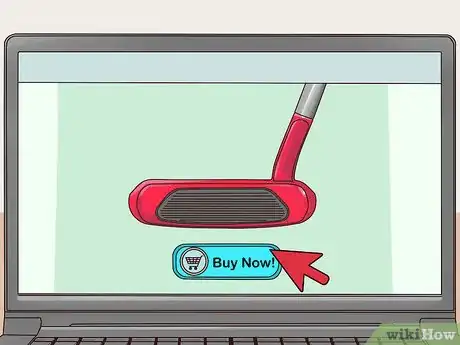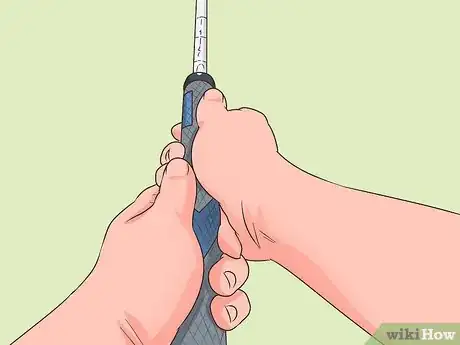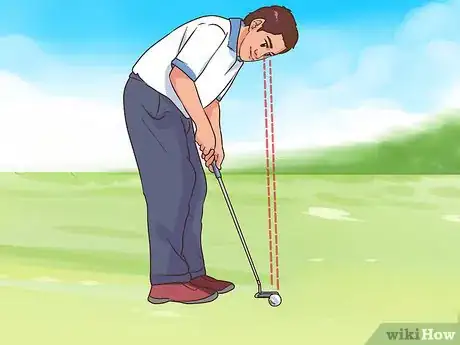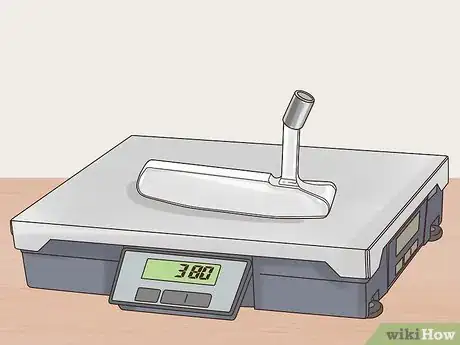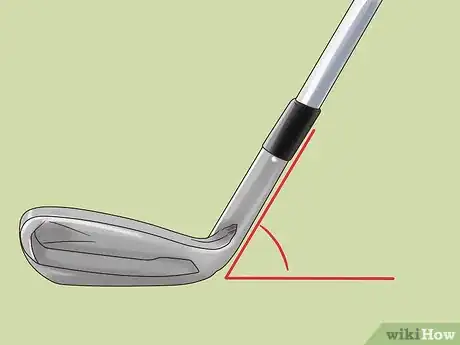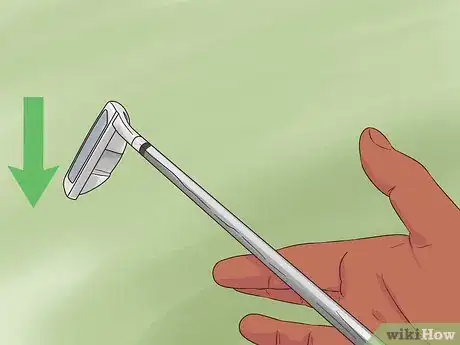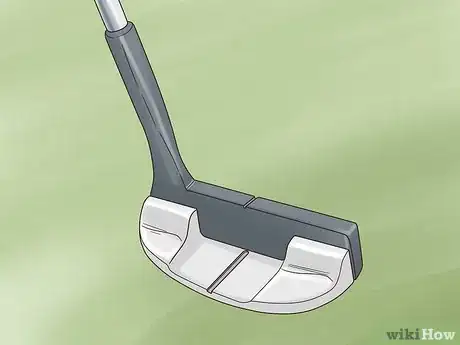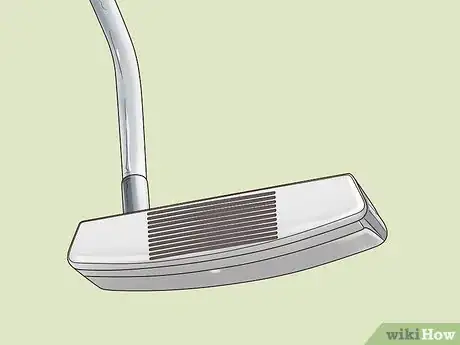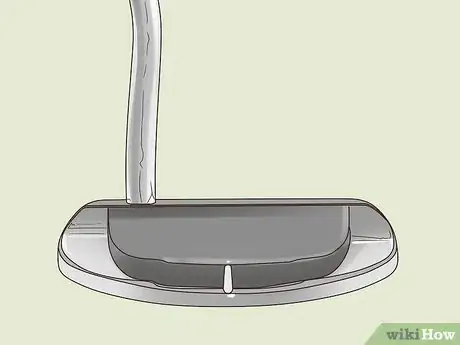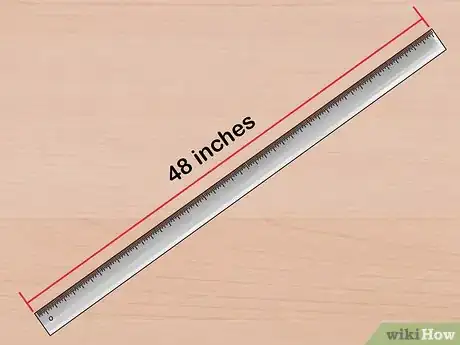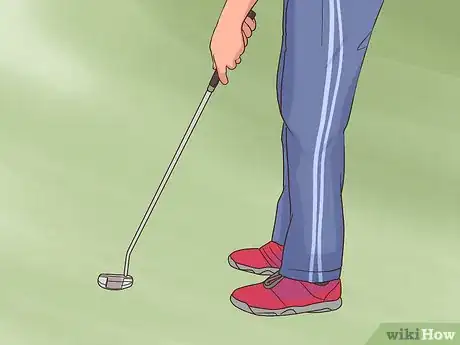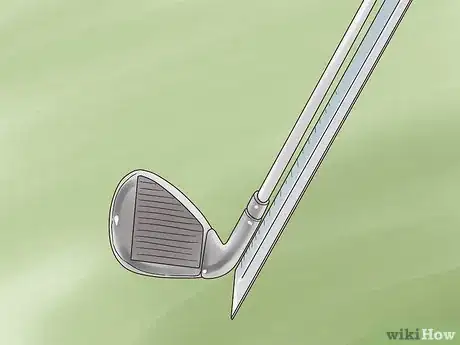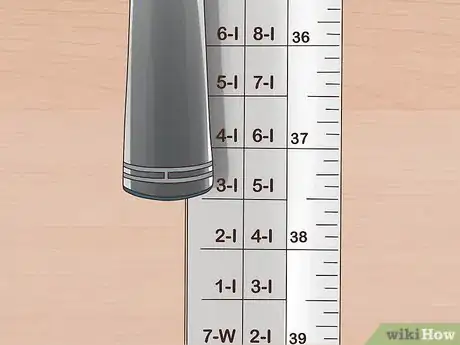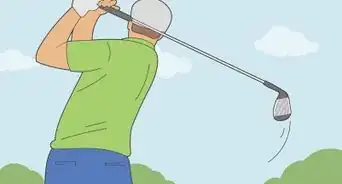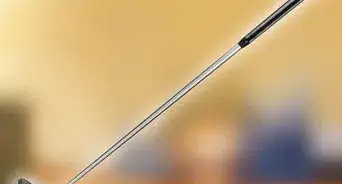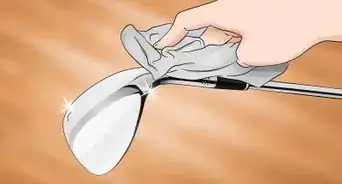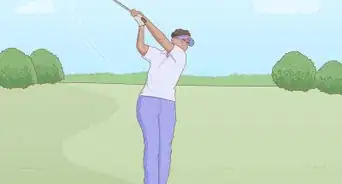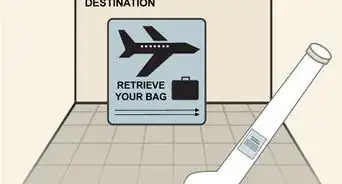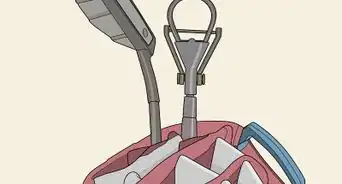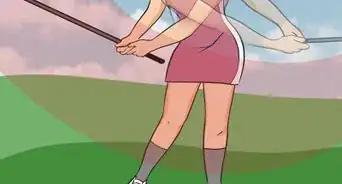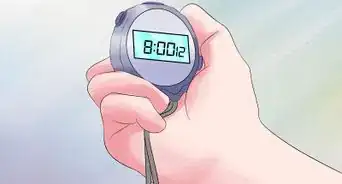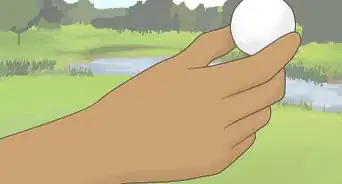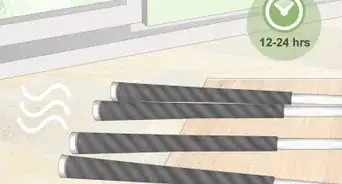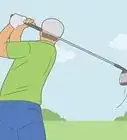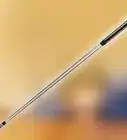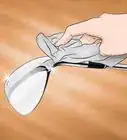This article was co-authored by Michael Metz. Michael Metz is a Golf Instructor and the Director of Instruction at Simi Hills Golf Course. With more than 15 years of experience, Michael is adept at coaching all facets of Golf. Mike uses technology, such as Flightscope, V1 Swing Suite, Blast Motion, and BodiTrak pressure mapping, to provide advanced golf training with quick results.
This article has been viewed 135,304 times.
If you love playing golf, you understand the value of a good putter. It’s important to use a putter that fit your size, stance, and needs. When measuring a putter, the most important thing to consider is the length that you need. After you determine your ideal putter length, you have other choices in specifications to ensure that your putter perfectly suited to you.
Steps
Finding the Right Length
-
1Shop for a putter in-store or online. If you need to find a putter that’s shorter or longer based on your assessment of your stance using your putter, you can find a new putter at sporting goods stores or online. Go to a sporting goods store in person if you would like assistance measuring and choosing a putter.[1]
- Shop online for at sporting goods websites if you know exactly what length you’re looking for.
-
2Choose a putter that’s comfortable to hold while in the putting stance. Approach the ball with your putter so that you are standing in front of the ball. Bend your waist forward comfortably so that your eyes are right above the ball. Bend your arms at the elbows so that they are lightly touching your ribcage, and aim the putter at the ball so that it’s lightly touching it.[2]
- A putter that fits you correctly should allow you to comfortably assume this position while gripping your putter so that your thumbs rest one above the other in the flat section on the front of the grip.
- Choose a putter that is based on your waist height, and how low your hands are.[3]
Advertisement -
3Make sure your thumbs are in the front flat area on the grip.[4] Your thumbs should be stacked 1 on top of the other in the flat area in the front of your putter’s grip. If you are gripping down the shaft of the putter in order to remain in the correct position, you need a shorter putter. If you are gripping it way up toward the top, past the flat area where your thumbs should be, you need a longer putter.[5]
- The shaft of the putter should be in line with your forearms. Adjusting your wrists to reach the ball during your stance with a putter that’s not your size can cause eventual injury to your wrists.
-
4Take note if your elbows are crowding your body. Your elbows should ever so lightly touch your ribcage in a correct stance with a putter that fits you well. If your elbows are wedged into your ribcage, this is the most obvious sign that your putter is too long for you.[6]
- Having your elbows too close with a putter that’s too long can disrupt your swing and make it off-center. Try a shorter putter.
-
5Ensure your eyes are directly above the ball when looking at it. Where your eyes fall above the ball is an important indication of how well your putter fits you. If you have to look out at the ball, it may be because you’re standing too far back because your putter is too long.[7]
- If your eyes are beyond the ball, and you have to almost look back a bit to see it, you’re standing too close or bending too much from your putter being too short.
-
6Avoid using a putter that makes your lower back uncomfortable. Any cramping or pressure in your lower back is an indication that you’re using a putter that’s too short for you. This happens because you are bending more at your hips than you should in order to reach the ball with your putter.[8]
- It can take some time to notice back strain from an ill-fitted putter, but if you start experiencing any discomfort in your lower back during or after golfing, checking your putter length should be your first step.
-
7Try a custom club-fitting if you have trouble finding the right length putter. If you’re unsure that you’ve been using the correct length putter because you’re having trouble making putts or are experiencing discomfort, a custom fitting could be very helpful.[9]
- A custom club fitter would even look into your putting style to help determine the best putter for you. These services can be expensive, but many golfers feel they are worth the cost to better your game.[10]
Choosing Other Specifications
-
1Match the club head weight to your club’s length. If you change the length of your club but not the weight of the club head, it can throw off your swing. Most standard 35 in (89 cm) putters have club weights of around .73 pounds (330 g). You should only run into the problem of the weight being off if you are using a putter with an adjustable head weight.[11]
- For a shorter 32–33 in (81–84 cm) putter, you’ll need a heavier .82–.84 lb (370–380 g) head weight. Longer putters will need head weights lighter than .73 lb (330 g).
- If you change out your putter entirely, the weight of the head should come already matched to the length of the putter.
-
2Ensure the head’s lie-angle matches its length. The club’s lie-angle is the direction the toe, or end, of the putter faces. Ideally, it should be about parallel to the ground when you’re in your correct stance. If it points upward, your ball could be pulled toward the left when you putt; if the toe points downward and the heel of the club is up, it can push your ball toward the right.[12]
- If the lie-angle of your putter doesn’t promote good posture and eye position over the ball, or if balls tend to veer off to a side instead of going straight when you’re putting, have your lie-angle adjusted by a club fitter or try to find a new putter.
-
3Choose a face-balanced putter for a straight stroke. There are 2 main types of putter heads: face-balanced and toe-balanced. On a face-balanced putter, the face of the head, or the side that hits the ball, goes up toward the sky while you’re holding your club in both hands parallel to the ground. These types of putter heads are best for someone who has a straight, square stroke.[13]
- Have a fellow golfer look at your natural putting stroke to determine if it is straight. If your putter always faces the target, and your stroke goes back and through in a straight line, then you have a straight putting stroke.
-
4Pick a toe-balanced putter for an arced stroke. Hold your club in both hands parallel to the ground. If the toe, or very end, of the putter hangs down toward the ground, that means it is a toe-balanced putter. These putters work best for someone who has an arc in their putting stroke.[14]
- Have someone watch your putting stroke. If it travels on a slight curve, you have an arced stroke and would benefit from using a toe-balanced putter.
-
5Go with a mallet head design for a straight stroke. Head designs on putters come in all different shapes and sizes, but the main ones are either a mallet head or a blade head. If you have a straight stroke, you may like a mallet head with a sight line.[15]
- Experiment with the different head designs at a club fitter’s store or driving range to determine your personal preference.
-
6Choose a blade head design if you have an arced stroke. If you have an arced stroke, or your stroke travels on a curve from start to finish, you may prefer a blade head with no sight line. This type of putter gives you more room to complete your stroke at an arc.[16]
-
7Consider a belly putter or long putter for “yips” or involuntary movements. Belly putters and long putters help control involuntary tremors during your stroke by anchoring the putter toward your stomach or chest and stabilizing the putter more. Steps for finding the correct length for a belly putter or long putter are the same as those for a regular putter.[17]
- Try a belly putter first if you have an arc stroke. It will provide you with more room for the putter to travel around your body.
- If you have a straight, or square stroke, the upright shaft of a long putter would probably work better for you.
- Try using belly putters and long putters during a club fitting or ask if they have some available at your local driving range.
Measuring Your Putter’s Length
-
1Obtain a sturdy 48 in (120 cm) aluminum ruler. When measuring a putter, a yard stick will be too short, and measuring tape will be too flexible. To get the most accurate measurement of your putter, use an aluminum or other metal ruler that’s at least 48 in (120 cm) in length.[18]
- Long metal rulers can be found at home improvement stores or online where construction supplies are sold.
-
2Position the putter with the center touching the ground. Your putter should have its center in contact with the ground during measurement to get the most accurate results. Don’t place the toe, or end, of the putter, or the heel of the putter, on the ground for your measurement.[19]
-
3Place the edge of the ruler back by the heel of the putter. The starting edge of your ruler should be back by the heel of your putter. Hold your ruler firmly along the back of your putter. Be sure the ruler is even with the putter and remaining close to it.[20]
-
4Check the number at the edge of your putter’s grip-cap. Look at where the edge of your putter’s grip-cap, or where the grip stops. The number at this point is the length of your putter.[21]
- Most regular putters come in lengths ranging from 32–36 in (81–91 cm). You can expect belly putters and long putters to be longer.
References
- ↑ http://www.golf-monthly.co.uk/features/the-game/which-putter-length-should-you-use-94751
- ↑ http://www.better-golf-by-putting-better.com/putter-fitting.html
- ↑ Michael Metz. Golf Instructor. Expert Interview. 24 March 2022.
- ↑ Michael Metz. Golf Instructor. Expert Interview. 24 March 2022.
- ↑ http://www.golf-monthly.co.uk/features/the-game/which-putter-length-should-you-use-94751
- ↑ http://www.golf-monthly.co.uk/features/the-game/which-putter-length-should-you-use-94751
- ↑ http://www.golf-monthly.co.uk/features/the-game/which-putter-length-should-you-use-94751
- ↑ http://www.golf-monthly.co.uk/features/the-game/which-putter-length-should-you-use-94751
- ↑ Michael Metz. Golf Instructor. Expert Interview. 24 March 2022.
- ↑ http://www.better-golf-by-putting-better.com/putter-fitting.html
- ↑ http://www.better-golf-by-putting-better.com/putter-fitting.html
- ↑ http://www.better-golf-by-putting-better.com/putter-fitting.html
- ↑ http://www.better-golf-by-putting-better.com/putter-fitting.html
- ↑ http://www.better-golf-by-putting-better.com/putter-fitting.html
- ↑ http://www.better-golf-by-putting-better.com/putter-fitting.html
- ↑ http://www.better-golf-by-putting-better.com/putter-fitting.html
- ↑ http://www.better-golf-by-putting-better.com/putter-fitting.html
- ↑ https://www.youtube.com/watch?v=adCW1axRn3E&feature=youtu.be&t=38
- ↑ https://www.youtube.com/watch?v=adCW1axRn3E&feature=youtu.be&t=59
- ↑ https://www.youtube.com/watch?v=adCW1axRn3E&feature=youtu.be&t=59
- ↑ https://www.youtube.com/watch?v=adCW1axRn3E&feature=youtu.be&t=89
About This Article
If you love playing golf, it’s important to use a putter that fits your size, stance, and needs. To test a putter, bend your waist forward so your eyes are right above the ball, bend your arms at the elbows so they lightly touch your ribcage, and aim the putter at the ball so it’s just touching it. If the putter fits you well, you’ll be able to assume this position comfortably with your thumbs stacked in the flat area on the front of your putter’s grip. If you find that your elbows are crowding your body or your eyes have to look out over your ball, then your putter is too long. Any cramping or pain in your lower back is a sign that your putter is too short. To learn how to match your club head weight to your club’s length, keep reading!
